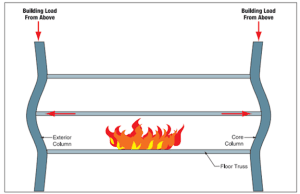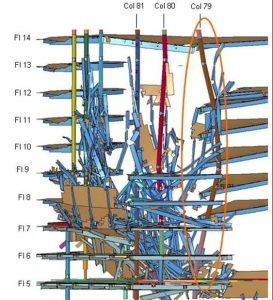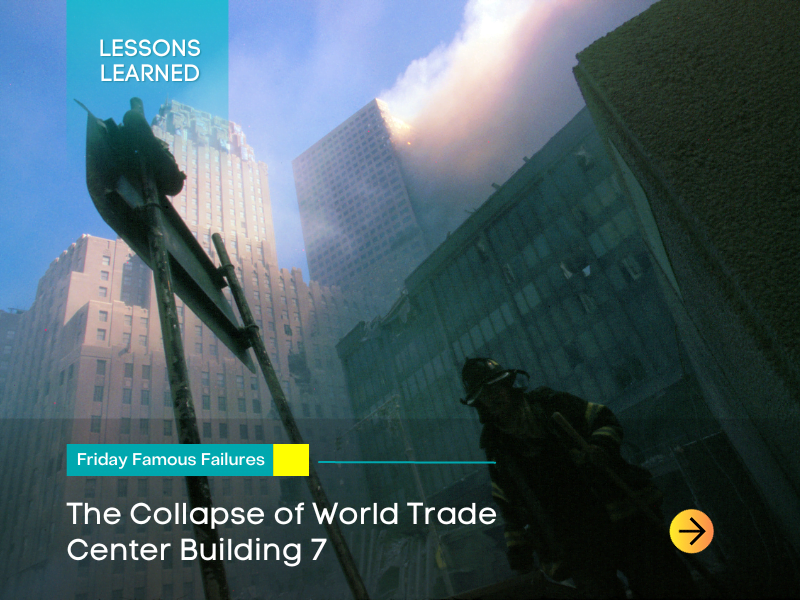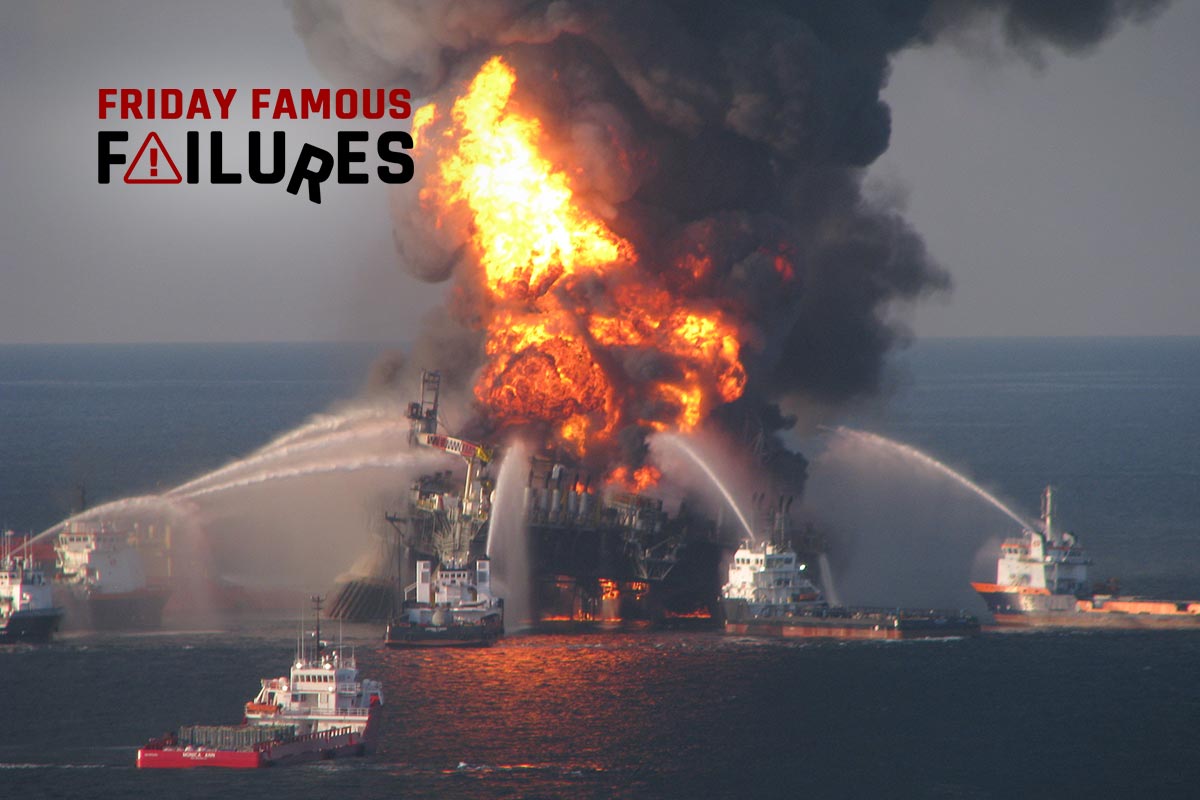The collapse of World Trade Center Building 7 (WTC 7) on September 11, 2001, has been a subject of intense study and debate within the engineering community. Unlike the Twin Towers, WTC 7 was not directly hit by an airplane, yet it collapsed completely, making it the first known instance of a tall building brought down primarily by uncontrolled fires. This article aims to explore the structural causes behind the collapse of WTC 7 from an engineering perspective.
WTC 7 was a 47-story building located just north of the Twin Towers. After the collapse of the Twin Towers earlier in the day, fires ignited in WTC 7, and the building collapsed later that afternoon. The National Institute of Standards and Technology (NIST) conducted an extensive investigation into the collapse and concluded that fires were the primary cause.
The structural design of WTC 7 was unique. It was built over an existing Con Edison substation, which required the use of long-span beams and girders to transfer loads from the building’s columns to the foundations. This design made the building more vulnerable to the effects of uncontrolled fires.
The fires in WTC 7 were ignited by debris from the collapse of the North Tower. These fires were fed by office furnishings and burned for almost seven hours without being fought due to lack of water supply and the focus on rescue efforts at the Twin Towers. The fires caused significant damage to the lower floors of the building, which contained critical structural columns and transfer trusses.
According to the NIST report, the collapse was initiated by the failure of a single column, Column 79, located in the eastern part of the building. The fires caused thermal expansion in the floor beams supporting this column, leading to a chain of events that resulted in the column’s failure.

Figure 1 – Expansion of floor slabs and framing which likely happened as a result of the fire

Figure 2 – Buckling of WTC 7 Column 79 (circled area)
As the fires continued, the thermal expansion of the floor beams led to a phenomenon known as “walk-off,” where the beams pushed against the girder connecting Columns 79 and 44, causing the girder to move off its seat. This led to the failure of the floors around Column 79, which in turn resulted in an increased load on the column. With the additional load and the loss of lateral support provided by the surrounding floors, Column 79 buckled, initiating the collapse.
Once Column 79 failed, it triggered a progressive collapse of the entire building. The loads from the failed column were redistributed to the other columns, causing them to fail in quick succession. This led to the collapse of the interior structure, followed by the exterior structure, resulting in the complete collapse of the building.
The collapse of WTC 7 provides valuable lessons for engineers and architects. It highlights the potential vulnerability of long-span steel structures to uncontrolled fires and the risk of progressive collapse. It also underscores the importance of fireproofing and the need for robust fire protection systems in tall buildings.

Figure 3 – WTC-7 after the collapse
In response to the collapse, changes have been made to building codes and practices, including the below.
- Fire Resistance: The collapse of WTC 7 underscored the importance of fire resistance in building design. As a result, building codes have been revised to require more robust fireproofing of structural elements. This includes stricter requirements for the application and adherence of fireproofing materials, and increased fire resistance ratings for structural components.
- Sprinkler Systems: The fires in WTC 7 were able to spread due to the failure of the building’s sprinkler system, which was rendered inoperable by the loss of the city’s water supply. In response, building codes now require increased redundancy in sprinkler systems, including the use of secondary water supplies.
- Risk Category IV: A new class of structures, known as “Risk Category IV,” has been included in building codes. This category covers buildings that, if they fail, could pose a substantial hazard to human life. Buildings in this category, which include high-rises and large assembly buildings, are subject to more stringent design requirements.
- Progressive Collapse: The collapse of WTC 7 was a classic example of progressive collapse, where the failure of a single structural element leads to the failure of the entire structure. Building codes have been revised to include provisions to prevent progressive collapse. These provisions require that buildings be designed to withstand the loss of one or more columns without collapsing.
- Increased Structural Integrity: Building codes now require increased structural integrity for buildings. This includes the use of more robust connections and the reinforcement of critical structural elements. The aim is to ensure that buildings can withstand extreme events without collapsing.
- Emergency Egress: The collapse of WTC 7 highlighted the importance of emergency egress in high-rise buildings. Building codes have been revised to require more robust and redundant egress systems, including increased stairwell width and additional stairwells in high-rise buildings.
In conclusion, the collapse of WTC 7 has had a profound impact on the field of structural engineering. It serves as a stark reminder of the potential risks associated with uncontrolled fires and the importance of robust structural design. The lessons learned from the collapse have led to significant changes in building codes and practices, with the aim of preventing similar failures in the future.









This entire study is balderdash and a complete waste of time at the best and an intended misleading at the worst. Numerous eye witness accounts near WTC 7 report the sounds of multiple explosions before the building collapse. A tiny bit or research will explain why this building was demolished.
I am a graduate Fire Protection Engineer U of MD and “we” studied the WTC design that resulted in 100% open floor space. All loads were handled by the outer steel walls, I later got a MS Civil/Structural Engineer. I question several Professors about the design being subject to being hit by a jet plane with fuel. In July 1945, the Empire Trade Bldg. got hit by a B-25 bomber and it handled the incident fine with no collapse. Professors laughed at me age 20 & 21. I knew WTC would never survive a direct jet plane hit!! Too bad I didnt write up an essay paper and saved it! I would appear today, lol, to be a building genius. On 911 at start of fire, I made many calls to warn the building would come down in 1 hour or so. I even called by FBI friend but to no avail. I was probably written off as a kook. WTC was a terrible concept from the start!! Turns out the NYC Fire Marshall felt the same way and carried WTC plans in his car but died at the scene that day.
I read about this some years ago. The structural design of WTC7 over the substation was a very complicated design. It looked much more like a complex 19th century bridge than a conventional building skeleton. I can easily envision the failure of one critical member cascading to the failure of the whole structure due to the lack of alternate load paths, particularly under extreme circumstances.
On the other hand, it’s also possible that WTC7’s designers intentionally designed in weaknesses and added explosives to WTC7’s bill-of-materials for future exploit by a malevolent government decades later.
I wonder which explanation is more plausible…
It’s not correct thinking to imagine that buildings should be designed to anticipate unprecedented events that load and stress structural framing members in ways that would cause building failure. There was not anything wrong about the way WTC7 was designed. You can’t design for a “terrorist attack”….buildings will fall when columns are removed…period. “The aim is to ensure that buildings can withstand extreme events without collapsing”… You would never see another building built under this ridiculous statement. Nobody could afford the cost of even attempting a building outcome that is this extreme.
The 9/11 events -when NEVER in modern history have (3)high rise buildings fallen into their own footprint on the same day. (Especially a 47 story WC7 which totally collapsed simultaneously from a single beam failure? ) The saddest part was the POOR FORENSICS done on the Tower steel. This should have been completely analyzed just like when a plane crash occurs. The forensic team rebuilds the airplane – piece by piece. Every beam and column in the towers is etched with ID markings and yet I have never seen any specific analysis of various beams and columns that sustained fire/stress/bending/buckling/warping phenomena. It was simply trucked away (not all) and salvaged/melted/scrapped before a THOROUGH evaluation was done. The steel would have “written” the story rather than someones sophisticated computer modelling.
Rick Category IV was NOT added after 9-11. In the IBC 2000 there were essentially the same 4 categories that are in IBC 2024. The only difference was that in 2000 they were numbered differently, with (I) as the normal buildings, (II) as high occupancy, (III) as emergency facilities, and (IV) as low-hazard buildings. They were renumbered in increasing order starting in 2003 but the definitions are still basically the same. A typical high-rise structure would still be a (III), not a (IV).
The NIST report is suspect, at best, and criminal balderdash at worst and I suspect the worst. WTC7, based on the computer model, would collapse towards the failing column, would it not? The building, if you watch the video, fell straight down! Right into its footprint. I agree that complete forensics would have told the story much better and a computer model is “garbage in = garbage out”. Color pics look good but any experienced engineer knows you can fudge a model to do whatever you want it to do.
NIST had a lawsuit filed against them by Dr. Judy Wood due to their incompetent investigation. Look at Dr. Wood’s videos online and read her book. NIST management, bless their hearts, was complicit in covering up evidence. Whenever I see the number of coincidences that occurred at this location, I no longer see coincidences but plans that have been deployed. I don’t claim to know the plan or how it was deployed, but I smell something rotten. Isn’t it more than ironic that the insurance policy for the site was recently updated to include coverage for “Terrorist Attacks”? And to say that WTC7 fell due to a terrorist attack is disingenuous – the claim in this report is that it fell due to a fire. Is it not true that the papers to support the spending of the Pentagon just happened to be in WTC7 and that Congress was investigating the Pentagon around the same time. Oops, Congress, we stored our papers in an entirely different city and they were unfortunately destroyed by those darn terrorists. Sorry, we don’t have the paperwork to support the missing $1 trillion. Trust us. We could have answered your questions if only not for those darn terrorists. Coincidence.
It doesn’t matter how the fire started. What was the fuel load? The building was used as designed and the fire was maintained due to fuel that was there only because of the purpose of the building – office furniture and papers. Not a huge fire load. It was a fire that was reportedly not extinguished by the fire suppression system due to a lack of water pressure, not due to first responders attending to victims in WTC 1 & 2. Misleading report and, not unusual, since people have become ever more suspicious of ‘the powers that be’ after the failed, and dare I say, criminal handling of public money, trust, and news media to create fear, compliance and wealth transfer through lies and deception in a manufactured pandemic, also not supported by ‘the science’. However, those that speak out in the medical arena, have their funds pulled and cancel culture comes after them. Be quiet, get your paycheck, drive your Mercedes and don’t worry about the masses. “Caveat Emptor! If you buy it without due diligence, your fault, not mine” is the rationalization used by the non-ethical people that have allowed abuse of the uneducated. Then, when caught in either their own ignorance and lack of due diligence/laziness, they claim “I didn’t know. Don’t blame me.” In effect, if you got two jabs and got myocarditist as a result, you have a 50% chance of dying in 5 years. Safe and effective? Effective at what? Check our what the life insurance actuaries are saying. There’s reportedly a 30% increase in excess deaths after the rollout and use of the jabs. A 10% increase is a 1 in 100 year occurrence. A 30% increase, their words not mine, is impossible.
Science and scientists are getting a black eye from misuse by bureaucrats, politicians, the mainstream media, and the wealthy that own all of them. Science looks at all angles of the situation, not just the narrative chosen by the powers that be or the narrative that fits our biases and makes us the most comfortable.
Fear and science are misused and abused in today’s society. Science is a tool and not a religion. Let’s keep it that way and turn this tide around. Stand up, even in small ways, and if something doesn’t look right, look into it. If you’re reading this you’re likely an engineer. You have a responsibility to keep a questioning mind and to not take what you’re being told for granted. Be an engineer, don’t be a robot.
NIST has been discredited, much to the chagrin of true scientists and engineers, and the CDC, in my opinion, has been discredited. This goes to show what happens when the funding comes from a wealthy entity or monopoly, in this case, the Federal Government. The result of the tower study had to be approved before it was released and, like the launch of the Challenger, was decided by the few managers in charge, not the engineers and scientists that knew better. It’s wet, but it ain’t rain.
Can I prove anything? Nope. The evidence, as mentioned by another commenter, was conveniently destroyed and computer models were used with a LOT of assumptions. The results are only as good as assumptions.
Engineers and scientists, it’s up to us to do what we can to right this ship. We have to remain ethical and risk losing our jobs if it means saving life, environment, freedom and liberty (in the USA, at least). It’s a tenuous balance. You don’t even have to be the rebel and speak out, but you can make little changes and ask good questions and most of all, maintain your integrity. And most of all, don’t just believe everything that comes out of the government agencies. Do your own due diligence and look at opposing points of view and find as close to the truth as possible. As an engineer, you owe it to yourself and your colleagues. Are you going to really believe that air compressor salesman without doing your due diligence? If it sounds too easy, there’s a reason. Be skeptical. Be a good engineer. Do it well; be well.